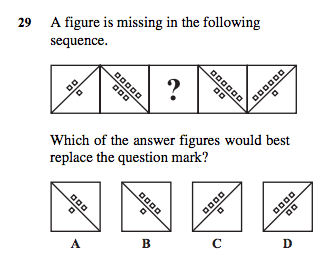9. Number Patterns
Sometimes number patterns occur in abstract reasoning. The numbers are usually represented by a visual symbol e.g. a dot or a line.
Number patterns appear in abstract reasoning because they are represented by imagery. However, in essence, you should treat them as numbers whenever you suspect it involves number patterns and quantity of images .
Such types of number patterns are:
- Increasing via addition, multiplication or other combination.
- Decreasing via subtraction, division or other combination.
Now, let's go through some sample questions:
Example 1

Source: http://www.schools.nsw.edu.au/media/downloads/schoolsweb/learning/k_6assessments/ss/gatest4.pdf
Why is this abstract reasoning question really a number pattern?
- It has quantities of dots.
- There's no visually evident pattern e.g. no repetition that would hold true.
- Therefore, look at the pattern for numbers.
Example 1

Why is this abstract reasoning question really a number pattern?
- It has multiple items of the same type.
- There are segments, division of items into spaces.
- A mix of number patterns and positioning exist in this abstract reasoning question.
Example 2

Why is this abstract reasoning question really a number pattern?
- It has multiple items of the same type.
- There are segments, division of items into spaces.
- A mix of number patterns, position and colouring exist in this abstract reasoning question.
Key Rules to remember:
- Identify that a number pattern is occurring when there are multiple quantities of a particular image.
- Increasing via addition, multiplication or other combination.
- Decreasing via subtraction, division or other combination.
Now it's time to do your assignment.
- Download the assignment question here.
- Print it out or if you want to do it electronically, save it.
- Complete the questions to it.
- Then check the solutions on the video below.
- For the answers in text instead of video, download them here.